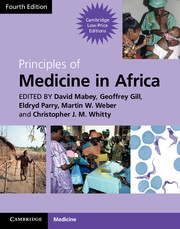Book contents
- Frontmatter
- Contents
- Contributors
- Foreword
- Section 1 Health and disease
- Section 2 Mother and child health
- Section 3 Infection: general principles
- Section 4 Major common infections
- Section 5 Bacterial infections
- Section 6 Viral Infections
- Section 7 Protozoal infections
- Section 8 Helminth infections
- 46 Intestinal helminths
- 47 Schistosomiasis
- 48 Lymphatic filariasis and loa loa
- 49 Onchocerciasis
- 50 Cysticercosis
- 51 Hydatid disease
- 52 Paragonimiasis
- 53 Trichinellosis
- 54 Guinea worm
- Section 9 Fungal infections
- Section 10 Non-communicable diseases
- Section 11 Diseases of body systems
- Section 12 Cancer and Palliative Care
- Section 13 Venoms and Poisons
- Index
- References
49 - Onchocerciasis
from Section 8 - Helminth infections
Published online by Cambridge University Press: 05 March 2013
- Frontmatter
- Contents
- Contributors
- Foreword
- Section 1 Health and disease
- Section 2 Mother and child health
- Section 3 Infection: general principles
- Section 4 Major common infections
- Section 5 Bacterial infections
- Section 6 Viral Infections
- Section 7 Protozoal infections
- Section 8 Helminth infections
- 46 Intestinal helminths
- 47 Schistosomiasis
- 48 Lymphatic filariasis and loa loa
- 49 Onchocerciasis
- 50 Cysticercosis
- 51 Hydatid disease
- 52 Paragonimiasis
- 53 Trichinellosis
- 54 Guinea worm
- Section 9 Fungal infections
- Section 10 Non-communicable diseases
- Section 11 Diseases of body systems
- Section 12 Cancer and Palliative Care
- Section 13 Venoms and Poisons
- Index
- References
Summary
The problem in Africa
Thirty-seven million people are estimated to have onchocerciasis, 99 per cent of them in sub-Saharan Africa. The disease is endemic in 27 African countries. Approximately 270 000 people are blind and 500 000 have significant visual loss due to onchocerciasis, though these figures are probably under-estimates. About 6 million people suffer from onchocercal skin lesions (Remme, 2004). In affected areas, up to one person in ten may be blind and more than one person in three over the age of 40, leading severely affected communities to abandon their villages. In one Nigerian community, adolescent girls considered onchodermatitis to be their most significant health problem because of its severe social consequences, and people in areas of Eastern Nigeria describe onchodermatitis as ‘Osepuru nwanyi aka na di’ meaning a disease which ‘prevents a girl from getting married’. Farmers with onchocercal skin disease (OSD) had significantly less farmland under cultivation and had a lower value of personal wealth indicators than those without OSD (Oladepo et al., 1997).
Organism, life cycle and vector
Onchocerciasis is spread by a small black fly of the genus Simulium. Subspecies of this fly have rainforest, Sudan and Guinea savannah as their natural habitat. All require fast-flowing, turbulent water for their larvae to develop, hence infection occurs in communities living near breeding sites and the illness has become known as river blindness.
- Type
- Chapter
- Information
- Principles of Medicine in Africa , pp. 456 - 465Publisher: Cambridge University PressPrint publication year: 2013
References
- 1
- Cited by



